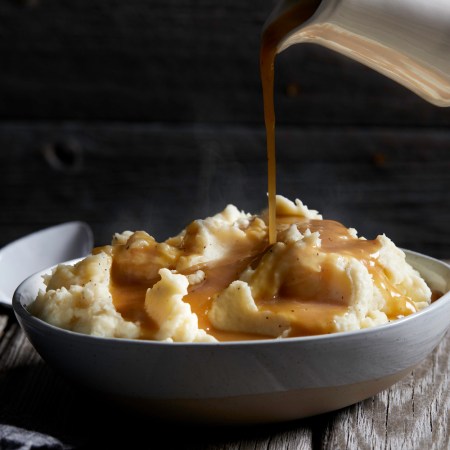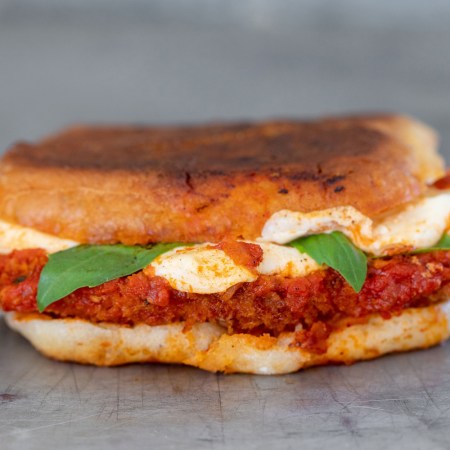Anyone who took the SAT before 2005 will remember the portion of the test wherein test-takers had to identify a missing word to complete a set of analogous linguistic relationships. (Runner: marathon as oarsman: regatta, went one particularly notorious example.)
Well, here’s one for all us old folks that even youngsters should understand: Ōra King is to salmon as Wagyu is to beef.
Sometimes likened to being the Wagyu of the sea and a favorite of top-tier chefs such as Daniel Boulud, Nobu Matsuhisa and Thomas Keller, the Ōra King brand refers to a unique breed of New Zealand king salmon that has been raised to be genetically distinct from every other fish in the world.
With a fat content hovering around 25 percent (a typical Atlantic salmon is closer to 15 -17 percent fat content), Ōra King’s salmon have been bred over the course of 10 generations to possess exceptional size, outstanding flesh color and a rich, unctuous taste.

“Fat is flavor and a nice Ōra King salmon has tons of flavor,” Ōra King VP and North America manager Michael Fabbro tells InsideHook. “It will also have a really nice texture and a great sense of umami. Just really marbled and rich. Decadent.”
Raised in an eco-friendly facility in freshwater that’s verified as being some of the clearest in the world, Ōra King’s fish live similarly to wild salmon but are higher in fat due to breeding and a lack of swimming upstream.
“We have a traditional husbandry breeding program. It’s not too dissimilar to raising thoroughbreds, where you’re breeding a male and a female for certain traits,” Fabbro says. “Through this selective breeding process, we’ve been able to really grow a distinct breed. We have over 300,000 individual salmon in our database and over 100 different family groups. They have bloodlines that go way back.”
Typically weighing in around 10 pounds, Ōra King’s salmon has been available in top restaurants in New York, Chicago and Los Angeles for almost a decade, but it’s now available for direct-to-consumer purchase via Goldbelly starting at around $30 per pound.

Available in the form of skin-on, pin-boned fillets, individual 6-oz. portions or an entire fish that that’s been gilled, gutted and cleaned, Ōra King’s salmon will melt in your mouth and burn a hole in your wallet — just like Wagyu.
“The Wagyu of salmon really describes what our salmon is all about,” Fabbro says. “It’s this luxurious, rich, amazing, marbled, flavorful salmon. It really is a fantastic eating experience. I think it comes down to that.”
Interested in beefing up the seafood in your life? Check out Chicago chef Stephanie Izard’s Peruvian-style take on the Ōra Kin from her restaurant Cabra below.

Stephanie Izard’s Salmon Saltado
Ingredients
- Fingerling potatoes
- Red pepper
- Cherry tomatoes
- Salmon
- Kosher salt
- Extra-virgin olive oil
- High-heat cooking oil (such as canola or vegetable oil
- This Little Goat went to Peru sauce
- Butter
- Pickled veggies
- Cilantro
- Mint
Directions
- Preheat the oven to 375 degrees. Line a baking sheet with parchment paper.
- Slice the fingerlings in half lengthwise. Remove the stem from the red pepper and scoop out the seeds. Slice into thin rounds, about 1cm thick.
- Toss pepper, fingerlings and tomatoes (separately) with olive oil. Place in separate quadrants on the prepared baking sheet. Sprinkle the entire tray with a pinch of kosher salt and place in the oven. Roast for about 20-25 minutes, tossing once halfway through, until potatoes and peppers are tender and beginning to brown and tomatoes begin to burst.
- Meanwhile, remove salmon from the packaging, pat to dry and season with salt. Coat a large oven-safe skillet with cooking oil and heat over medium heat.
- Once the oil is hot but not smoking, carefully place salmon in the pan skin side down. Continue cooking over medium heat until the skin begins to turn golden brown and crisp up, about 2 minutes. If the edges of your salmon start to fold in, gently press on the fish with a spatula to ensure even browning.
- Add 1 tablespoon of butter to the pan alongside the salmon and transfer to the oven. Roast, flipping halfway through, until the fish is cooked to desired doneness, about 3-5 minutes per side. (If you do not have an oven-safe skillet, transfer your salmon to a baking sheet before placing it in the oven).
- Remove veggies and salmon from the oven and transfer cooked fish to a baking sheet, plate or cutting board to rest. If there is a lot of excess oil in the pan used to cook the fish, dump some out, leaving about a tablespoon in the pan.
- Add 2 more tablespoons of butter to the pan used to cook the salmon along with the This Little Goat went to Peru sauce. Heat to a gentle simmer over medium/medium-low heat. Continue simmering, stirring frequently, until the butter has melted into the sauce, creating a smooth, silky texture.
- Divide fingerlings and peppers evenly among your serving plates. Top each plate with a piece of salmon, roasted tomatoes and pickled onion and fresnos. Finish with a drizzle of buttery Peru sauce and torn leaves of fresh mint and cilantro. Serve any extra sauce on the side.
This article was featured in the InsideHook newsletter. Sign up now.


















